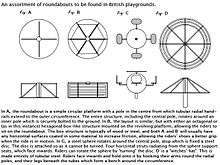Roundabout (play)
A playground roundabout (or merry-go-round) is a flat disk, frequently about 2 to 3 metres (6 ft 7 in to 9 ft 10 in) in diameter, with bars on it that act as both hand-holds and something to lean against while riding. The disk can be made to spin by pushing or pulling on its handles, either by running around the outside, or by pulling and re-grabbing as it spins, from a stationary stance. Often found in school yards or in parks, these offer riders (typically children) a dizzying ride when either others spin the wheel, or by spinning it themselves by running around it, and then jumping on. People may take turns between riding and spinning. One type of roundabout which differs significantly in terms of how the rotary motion is provided is a Swedish device called the HAGS Pedal Roundabout, which resembles four small exercise bikes attached to a tubular steel ring, which travel on a circular steel rail on the ground. The ring is attached to a vertical pole in the center by four spokes. There is a driving wheel hidden under the casing of each of the "exercise bikes" (the casings prevent toes being run over) and the roundabout is turned by the pedaling action of the riders.[1]

Both "roundabout" and "merry-go-round" are also often synonyms for carousel.
The playground roundabout is a simplified version of a fairground carousel.
The roundabout uses rotary motion, which means it spins around in a circle either clockwise or counter-clockwise.
Innovation
An inventor, Ronnie Stuiver, devised a pump powered by a turning children's roundabout, which premiered at an agricultural show in KwaZulu-Natal in 1989.[2] This device is known as the Roundabout PlayPump. There are about 600 PlayPumps in South Africa, intended to provide clean drinking water to about one million impoverished people.
Several issues have been raised about the effectiveness of using such a pump as a power source given how consistent the need for water is, thereby turning children into a source of manual labor. Additionally The Guardian has pointed out that the problem for water infrastructure is often not the ability to pump ground water that pools close to the surface, but the limited availability of groundwater itself. UNICEF has released a comprehensive report on the current status of the PlayPump project.[3]
See also
- Empower playgrounds – energy generation
References
| Wikimedia Commons has media related to playground roundabouts. |